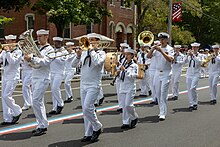Fleet Band Activities

Fleet Band Activities (FBA), formerly the Navy Music Program (NMP), is the central management office for nine active-duty fleet bands of the
The earliest pieces of military music in the
Premier Bands

The
Officially formed in November 1852, the
Fleet Bands in the continental United States
Navy Band Southwest is one of the Navy's oldest continuing musical organizations. The band serves as the musical ambassador for
Navy Band Great Lakes performs in a nine-state area of responsibility stretching from Indiana to North Dakota. As its name implies, it is located near the Great Lakes, specifically Naval Station Great Lakes where it serves under Naval Service Training Command. It also provides support to the local Recruit Training Command in supporting naval recruits during ceremonies in their basic training.[6] From 1911 to 1917, navy uniform regulations prescribed that the band wear US Marine Corps Uniforms[7] (without USMC) in performance. From 1917 onward the band wore the famous "Crackerjack" uniforms. Navy Band Great Lakes was instrumental in cultural change in the during World War II, having enlisted black musicians, and even creating integrated Navy Bands later on.
Notable members of the band include composer John Philip Sousa, trumpeter Clark Terry, saxophonist Von Freeman, trombonist Al Grey, composer and conductor Gerald Wilson, saxophonist Lou Donaldson, composer and arranger Luther Henderson, Major Holley.

Navy Band Northeast was officially established in 1974, located at Naval Station Newport in Newport Rhode Island. Navy Bands in Newport have previously dated back at least to the era of the American Civil War. It currently serves communities throughout the Northeastern United States.
Fleet Forces Band
The Norfolk, Virginia based Fleet Forces Band is the musical representative for the Commander, U.S. Fleet Forces Command, and is the largest of the 10 fleet bands.
Navy Band Southeast was established in October 1995. It represents the Navy Region Southeast and serves throughout Florida and the Southeastern United States. The band consists of 31-one professional musicians. It is notable in that it was the unit to which American Idol finalist Phil Stacey was assigned while on active duty (he was part of the "Pride" ensemble as well as with the wind and ceremonial bands).[8] His success on the show benefited the band by drawing in an estimated 2.4 million dollars.[citation needed]
Fleet Bands outside the continental U.S.
Pacific Fleet Band
The

The
Seventh Fleet Band

The
Support Unit
The Repair Division was established to provide the material support in the operation of Fleet bands both afloat and ashore. It comprises professional Navy musicians and civilians who operate out of
School of Music
Located aboard the Naval Amphibious Base in Norfolk, Virginia, the Naval School of Music provides specialized training for selected personnel of the Army, Navy, and Marine Corps. It is also the first institution musicians attend following basic training. Graduates of the Navy School of Music go on to serve throughout the Army, Navy, and Marine Corps as members of the military bands of these three branches.
In June 1935, the Navy School of Music was opened, operating in conjunction with the United States Navy Band until becoming an independent entity in 1942. Students enrolled at the School during this era graduated as complete ensembles—transferring as a unit to serve aboard ships in the U.S. Fleet. Unit Band No. 22, for example, was deployed to
, Army students began being enrolled in January 1951. On 13 December 1951, the first women to graduate from the Naval School of Music received their diplomas.See also
- United States military bands
- U.S. Navy Steel Band
- Anchors Aweigh
- Navy bands in Canada
- Navy Office of Community Outreach
- Marine Corps Musician Enlistment Option Program
Notes and references
This article includes a list of general references, but it lacks sufficient corresponding inline citations. (October 2008) |
- ^ At the end of World War II, Parsons went to law school and later became a United States federal judge.
- ^ http://navymusicians.org/site/mobile?url=http%3A%2F%2Fnavymusicians.org%2FNavy_Music_History.html#2739 [dead link]
- ^ Alex Albright, The Forgotten First: B-1 and the Integration of the Modern Navy. Fountain, NC: R.A. Fountain, 2013
- ^ Schudel Sunday, 29 March 2009, p.
- ^ "The U.S. Naval Academy Band". Archived from the original on 17 February 2007. Retrieved 1 March 2007.
- ^ "Navy Band Great Lakes". Archived from the original on 4 May 2019.
- ^ "(1917) Uniform Regulations United States Navy | Marksman | Officer (Armed Forces)". Scribd. Retrieved 3 October 2019.
- ^ "Singing Sailor May Go Overseas".
Sources
![]() This article incorporates public domain material from websites or documents of the United States Navy.
This article incorporates public domain material from websites or documents of the United States Navy.
- Navy Band Northwest
- Navy Band Southwest
- Navy Band Great Lakes
- Navy Band Northeast
- Navy Band Southeast
- The United States Fleet Forces Band
- Pacific Fleet Band
- US Naval Forces Europe Band
- US Seventh Fleet Band
- The United States Navy Band
- US Naval Academy Band
- Navy School of Music Archived 20 May 2011 at the Wayback Machine
External links
- USS Arizona's last band Archived 12 August 2020 at the Wayback Machine
- Navy Music History[permanent dead link]

